Vermicompost: Benefits in Organic Agriculture and Horticulture
VerifiedAdded on 2021/06/17
|20
|5530
|73
Report
AI Summary
This report delves into the significant role of vermicompost in organic agriculture and horticulture, highlighting its benefits for plant growth and soil health. The report begins with an introduction to organic agriculture and vermicomposting, explaining the process and importance of vermicompost. It explores the positive effects of vermicompost on seedlings, roots, shoots, flowers, and overall crop yield. The report also emphasizes the advantages of vermicompost over chemical fertilizers, including its waste recycling capabilities, cost-effectiveness, environmental benefits, and nutrient enrichment. Key findings demonstrate that vermicompost enhances soil aeration, water retention, and nutrient availability, ultimately leading to improved plant growth and sustainable farming practices. The report concludes by summarizing the importance of vermicompost as a beneficial amendment for plant growth and a sustainable alternative to chemical fertilizers.
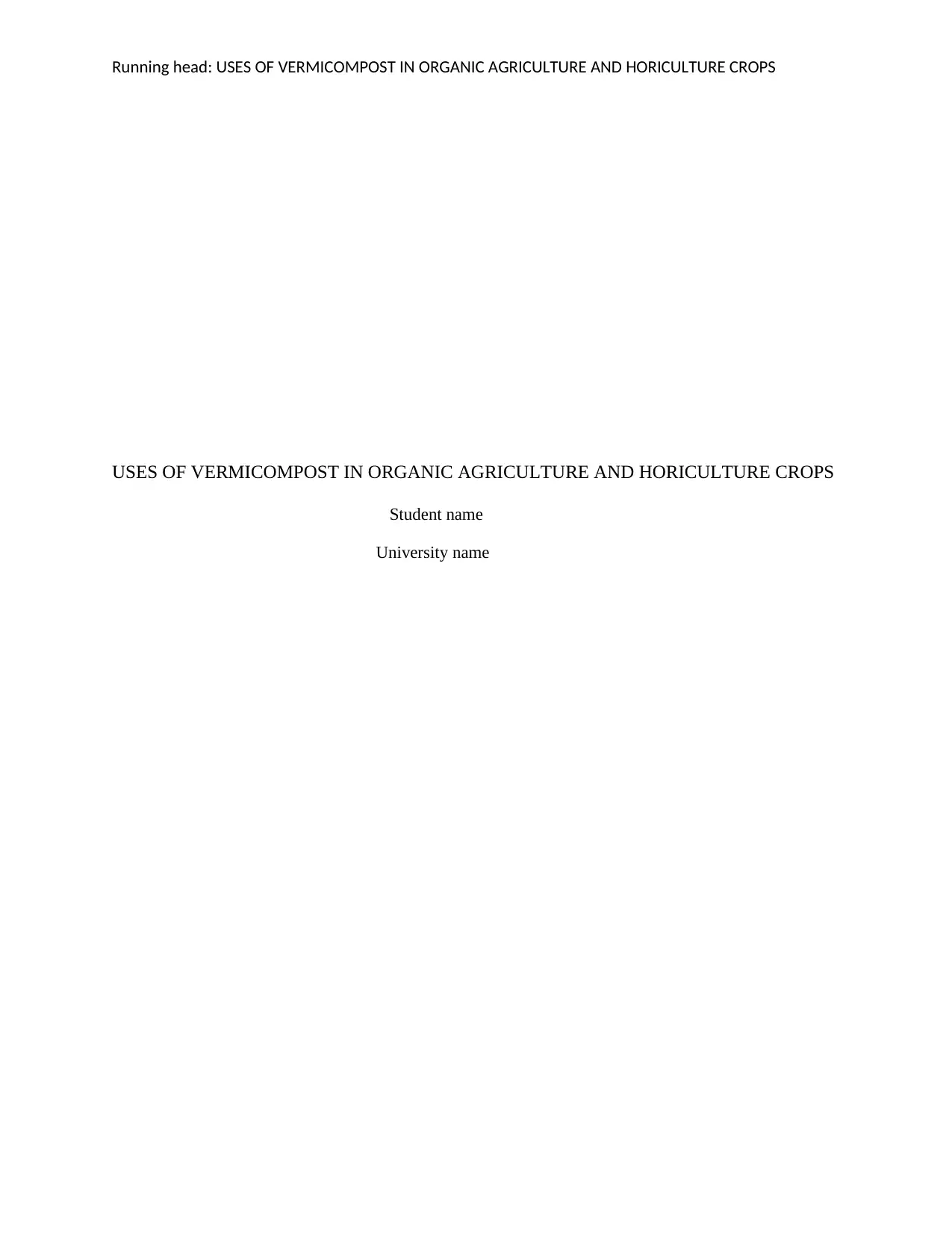
Running head: USES OF VERMICOMPOST IN ORGANIC AGRICULTURE AND HORICULTURE CROPS
USES OF VERMICOMPOST IN ORGANIC AGRICULTURE AND HORICULTURE CROPS
Student name
University name
USES OF VERMICOMPOST IN ORGANIC AGRICULTURE AND HORICULTURE CROPS
Student name
University name
Paraphrase This Document
Need a fresh take? Get an instant paraphrase of this document with our AI Paraphraser
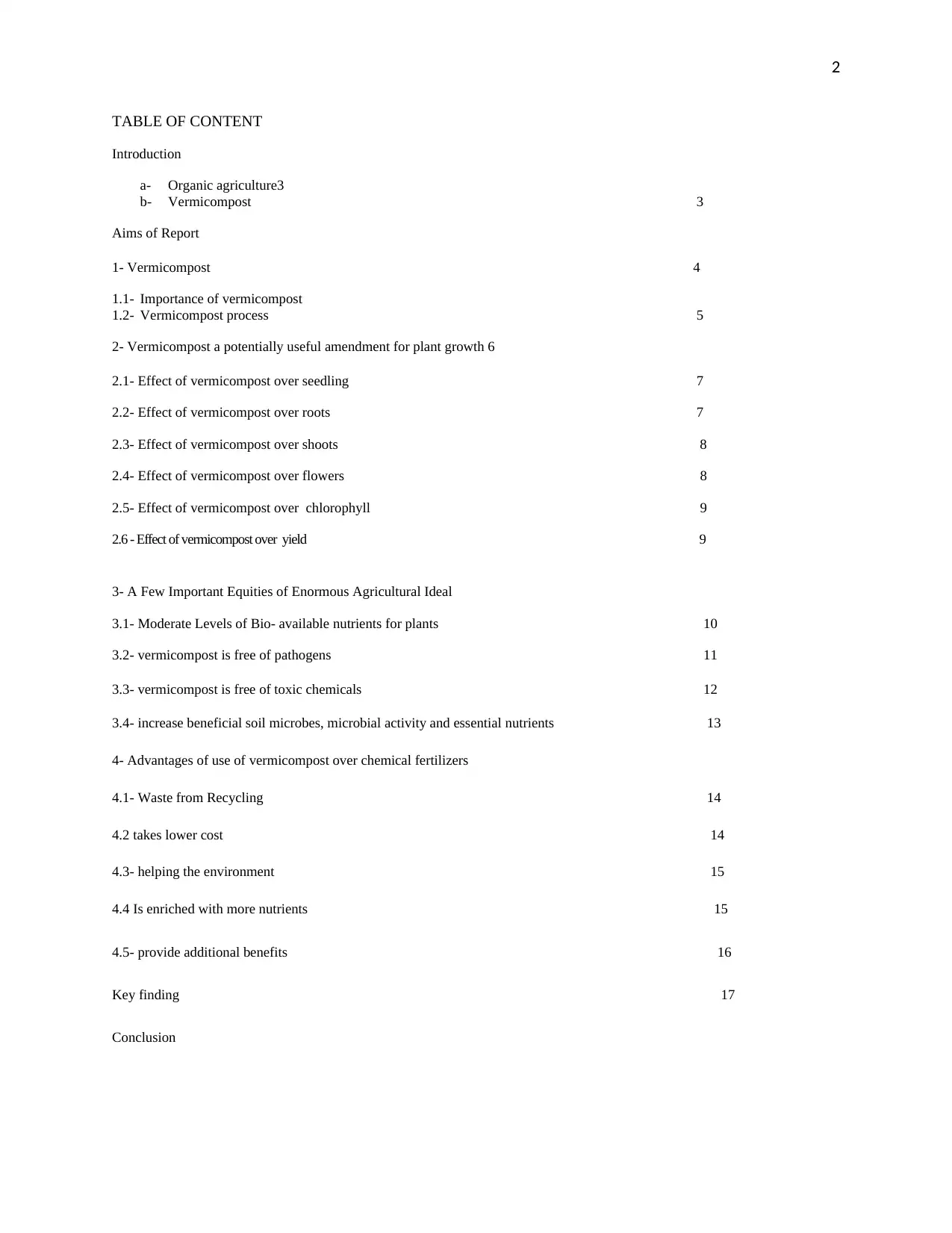
2
TABLE OF CONTENT
Introduction
a- Organic agriculture3
b- Vermicompost 3
Aims of Report
1- Vermicompost 4
1.1- Importance of vermicompost
1.2- Vermicompost process 5
2- Vermicompost a potentially useful amendment for plant growth 6
2.1- Effect of vermicompost over seedling 7
2.2- Effect of vermicompost over roots 7
2.3- Effect of vermicompost over shoots 8
2.4- Effect of vermicompost over flowers 8
2.5- Effect of vermicompost over chlorophyll 9
2.6 - Effect of vermicompost over yield 9
3- A Few Important Equities of Enormous Agricultural Ideal
3.1- Moderate Levels of Bio- available nutrients for plants 10
3.2- vermicompost is free of pathogens 11
3.3- vermicompost is free of toxic chemicals 12
3.4- increase beneficial soil microbes, microbial activity and essential nutrients 13
4- Advantages of use of vermicompost over chemical fertilizers
4.1- Waste from Recycling 14
4.2 takes lower cost 14
4.3- helping the environment 15
4.4 Is enriched with more nutrients 15
4.5- provide additional benefits 16
Key finding 17
Conclusion
TABLE OF CONTENT
Introduction
a- Organic agriculture3
b- Vermicompost 3
Aims of Report
1- Vermicompost 4
1.1- Importance of vermicompost
1.2- Vermicompost process 5
2- Vermicompost a potentially useful amendment for plant growth 6
2.1- Effect of vermicompost over seedling 7
2.2- Effect of vermicompost over roots 7
2.3- Effect of vermicompost over shoots 8
2.4- Effect of vermicompost over flowers 8
2.5- Effect of vermicompost over chlorophyll 9
2.6 - Effect of vermicompost over yield 9
3- A Few Important Equities of Enormous Agricultural Ideal
3.1- Moderate Levels of Bio- available nutrients for plants 10
3.2- vermicompost is free of pathogens 11
3.3- vermicompost is free of toxic chemicals 12
3.4- increase beneficial soil microbes, microbial activity and essential nutrients 13
4- Advantages of use of vermicompost over chemical fertilizers
4.1- Waste from Recycling 14
4.2 takes lower cost 14
4.3- helping the environment 15
4.4 Is enriched with more nutrients 15
4.5- provide additional benefits 16
Key finding 17
Conclusion
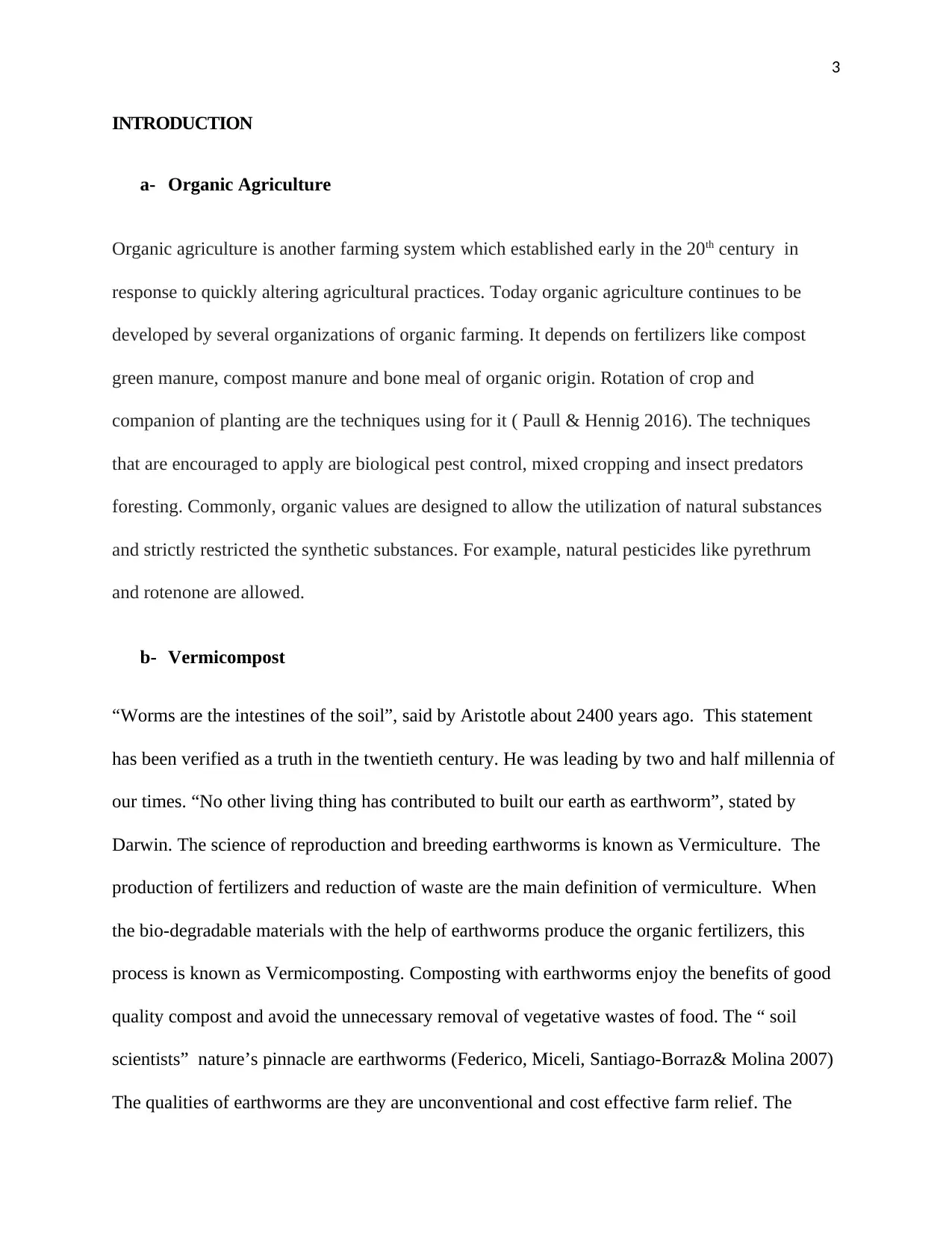
3
INTRODUCTION
a- Organic Agriculture
Organic agriculture is another farming system which established early in the 20th century in
response to quickly altering agricultural practices. Today organic agriculture continues to be
developed by several organizations of organic farming. It depends on fertilizers like compost
green manure, compost manure and bone meal of organic origin. Rotation of crop and
companion of planting are the techniques using for it ( Paull & Hennig 2016). The techniques
that are encouraged to apply are biological pest control, mixed cropping and insect predators
foresting. Commonly, organic values are designed to allow the utilization of natural substances
and strictly restricted the synthetic substances. For example, natural pesticides like pyrethrum
and rotenone are allowed.
b- Vermicompost
“Worms are the intestines of the soil”, said by Aristotle about 2400 years ago. This statement
has been verified as a truth in the twentieth century. He was leading by two and half millennia of
our times. “No other living thing has contributed to built our earth as earthworm”, stated by
Darwin. The science of reproduction and breeding earthworms is known as Vermiculture. The
production of fertilizers and reduction of waste are the main definition of vermiculture. When
the bio-degradable materials with the help of earthworms produce the organic fertilizers, this
process is known as Vermicomposting. Composting with earthworms enjoy the benefits of good
quality compost and avoid the unnecessary removal of vegetative wastes of food. The “ soil
scientists” nature’s pinnacle are earthworms (Federico, Miceli, Santiago-Borraz& Molina 2007)
The qualities of earthworms are they are unconventional and cost effective farm relief. The
INTRODUCTION
a- Organic Agriculture
Organic agriculture is another farming system which established early in the 20th century in
response to quickly altering agricultural practices. Today organic agriculture continues to be
developed by several organizations of organic farming. It depends on fertilizers like compost
green manure, compost manure and bone meal of organic origin. Rotation of crop and
companion of planting are the techniques using for it ( Paull & Hennig 2016). The techniques
that are encouraged to apply are biological pest control, mixed cropping and insect predators
foresting. Commonly, organic values are designed to allow the utilization of natural substances
and strictly restricted the synthetic substances. For example, natural pesticides like pyrethrum
and rotenone are allowed.
b- Vermicompost
“Worms are the intestines of the soil”, said by Aristotle about 2400 years ago. This statement
has been verified as a truth in the twentieth century. He was leading by two and half millennia of
our times. “No other living thing has contributed to built our earth as earthworm”, stated by
Darwin. The science of reproduction and breeding earthworms is known as Vermiculture. The
production of fertilizers and reduction of waste are the main definition of vermiculture. When
the bio-degradable materials with the help of earthworms produce the organic fertilizers, this
process is known as Vermicomposting. Composting with earthworms enjoy the benefits of good
quality compost and avoid the unnecessary removal of vegetative wastes of food. The “ soil
scientists” nature’s pinnacle are earthworms (Federico, Miceli, Santiago-Borraz& Molina 2007)
The qualities of earthworms are they are unconventional and cost effective farm relief. The
⊘ This is a preview!⊘
Do you want full access?
Subscribe today to unlock all pages.

Trusted by 1+ million students worldwide
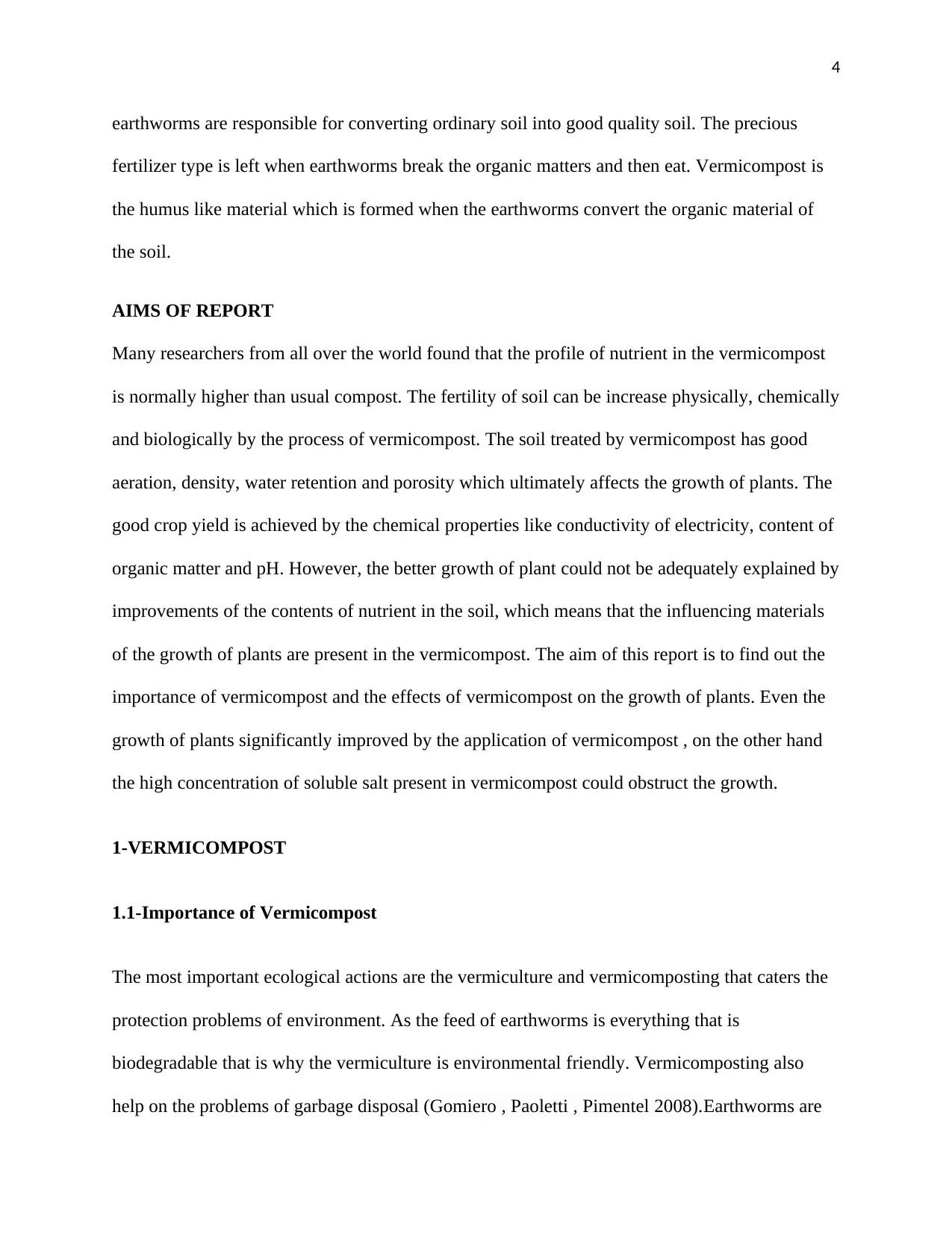
4
earthworms are responsible for converting ordinary soil into good quality soil. The precious
fertilizer type is left when earthworms break the organic matters and then eat. Vermicompost is
the humus like material which is formed when the earthworms convert the organic material of
the soil.
AIMS OF REPORT
Many researchers from all over the world found that the profile of nutrient in the vermicompost
is normally higher than usual compost. The fertility of soil can be increase physically, chemically
and biologically by the process of vermicompost. The soil treated by vermicompost has good
aeration, density, water retention and porosity which ultimately affects the growth of plants. The
good crop yield is achieved by the chemical properties like conductivity of electricity, content of
organic matter and pH. However, the better growth of plant could not be adequately explained by
improvements of the contents of nutrient in the soil, which means that the influencing materials
of the growth of plants are present in the vermicompost. The aim of this report is to find out the
importance of vermicompost and the effects of vermicompost on the growth of plants. Even the
growth of plants significantly improved by the application of vermicompost , on the other hand
the high concentration of soluble salt present in vermicompost could obstruct the growth.
1-VERMICOMPOST
1.1-Importance of Vermicompost
The most important ecological actions are the vermiculture and vermicomposting that caters the
protection problems of environment. As the feed of earthworms is everything that is
biodegradable that is why the vermiculture is environmental friendly. Vermicomposting also
help on the problems of garbage disposal (Gomiero , Paoletti , Pimentel 2008).Earthworms are
earthworms are responsible for converting ordinary soil into good quality soil. The precious
fertilizer type is left when earthworms break the organic matters and then eat. Vermicompost is
the humus like material which is formed when the earthworms convert the organic material of
the soil.
AIMS OF REPORT
Many researchers from all over the world found that the profile of nutrient in the vermicompost
is normally higher than usual compost. The fertility of soil can be increase physically, chemically
and biologically by the process of vermicompost. The soil treated by vermicompost has good
aeration, density, water retention and porosity which ultimately affects the growth of plants. The
good crop yield is achieved by the chemical properties like conductivity of electricity, content of
organic matter and pH. However, the better growth of plant could not be adequately explained by
improvements of the contents of nutrient in the soil, which means that the influencing materials
of the growth of plants are present in the vermicompost. The aim of this report is to find out the
importance of vermicompost and the effects of vermicompost on the growth of plants. Even the
growth of plants significantly improved by the application of vermicompost , on the other hand
the high concentration of soluble salt present in vermicompost could obstruct the growth.
1-VERMICOMPOST
1.1-Importance of Vermicompost
The most important ecological actions are the vermiculture and vermicomposting that caters the
protection problems of environment. As the feed of earthworms is everything that is
biodegradable that is why the vermiculture is environmental friendly. Vermicomposting also
help on the problems of garbage disposal (Gomiero , Paoletti , Pimentel 2008).Earthworms are
Paraphrase This Document
Need a fresh take? Get an instant paraphrase of this document with our AI Paraphraser
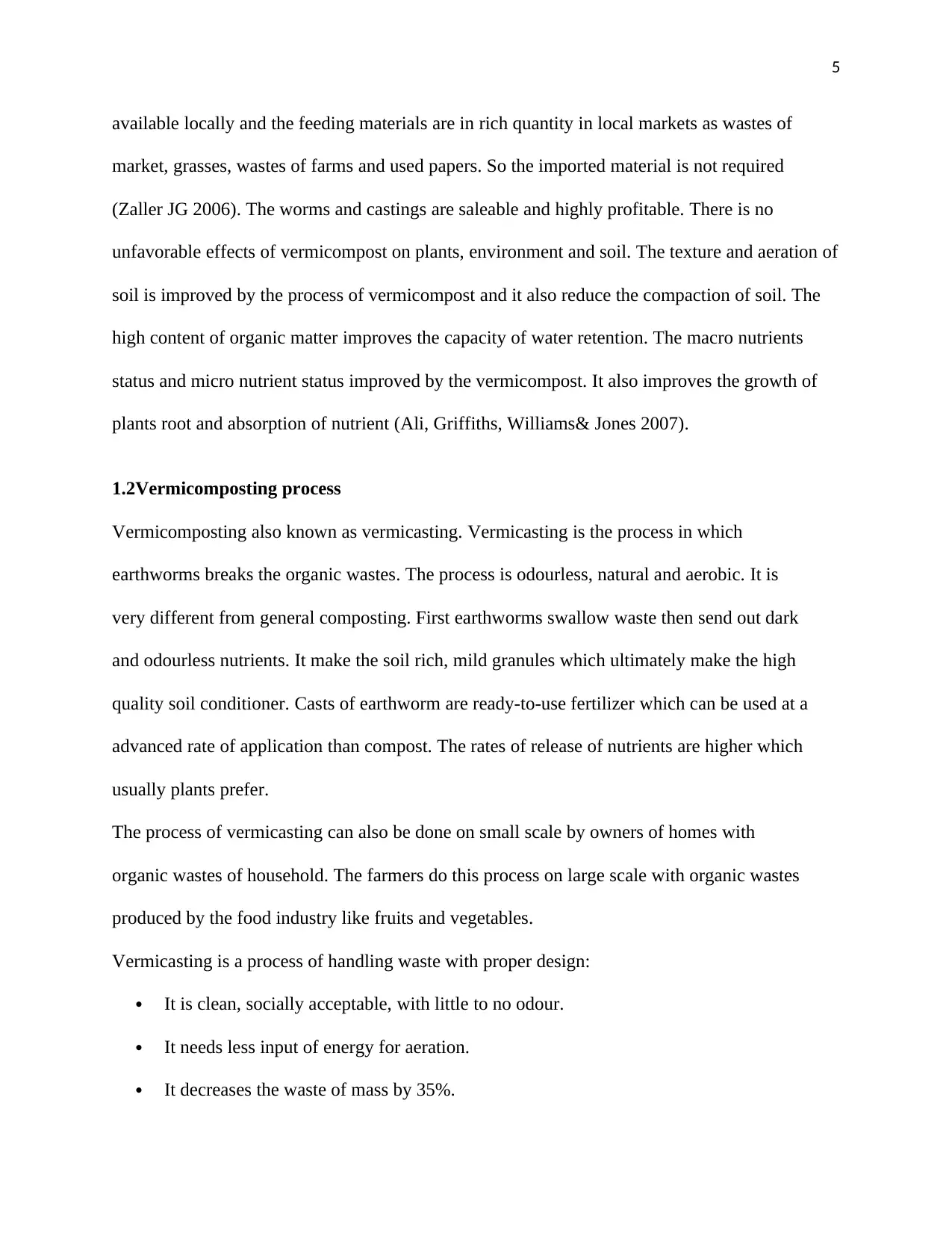
5
available locally and the feeding materials are in rich quantity in local markets as wastes of
market, grasses, wastes of farms and used papers. So the imported material is not required
(Zaller JG 2006). The worms and castings are saleable and highly profitable. There is no
unfavorable effects of vermicompost on plants, environment and soil. The texture and aeration of
soil is improved by the process of vermicompost and it also reduce the compaction of soil. The
high content of organic matter improves the capacity of water retention. The macro nutrients
status and micro nutrient status improved by the vermicompost. It also improves the growth of
plants root and absorption of nutrient (Ali, Griffiths, Williams& Jones 2007).
1.2Vermicomposting process
Vermicomposting also known as vermicasting. Vermicasting is the process in which
earthworms breaks the organic wastes. The process is odourless, natural and aerobic. It is
very different from general composting. First earthworms swallow waste then send out dark
and odourless nutrients. It make the soil rich, mild granules which ultimately make the high
quality soil conditioner. Casts of earthworm are ready-to-use fertilizer which can be used at a
advanced rate of application than compost. The rates of release of nutrients are higher which
usually plants prefer.
The process of vermicasting can also be done on small scale by owners of homes with
organic wastes of household. The farmers do this process on large scale with organic wastes
produced by the food industry like fruits and vegetables.
Vermicasting is a process of handling waste with proper design:
It is clean, socially acceptable, with little to no odour.
It needs less input of energy for aeration.
It decreases the waste of mass by 35%.
available locally and the feeding materials are in rich quantity in local markets as wastes of
market, grasses, wastes of farms and used papers. So the imported material is not required
(Zaller JG 2006). The worms and castings are saleable and highly profitable. There is no
unfavorable effects of vermicompost on plants, environment and soil. The texture and aeration of
soil is improved by the process of vermicompost and it also reduce the compaction of soil. The
high content of organic matter improves the capacity of water retention. The macro nutrients
status and micro nutrient status improved by the vermicompost. It also improves the growth of
plants root and absorption of nutrient (Ali, Griffiths, Williams& Jones 2007).
1.2Vermicomposting process
Vermicomposting also known as vermicasting. Vermicasting is the process in which
earthworms breaks the organic wastes. The process is odourless, natural and aerobic. It is
very different from general composting. First earthworms swallow waste then send out dark
and odourless nutrients. It make the soil rich, mild granules which ultimately make the high
quality soil conditioner. Casts of earthworm are ready-to-use fertilizer which can be used at a
advanced rate of application than compost. The rates of release of nutrients are higher which
usually plants prefer.
The process of vermicasting can also be done on small scale by owners of homes with
organic wastes of household. The farmers do this process on large scale with organic wastes
produced by the food industry like fruits and vegetables.
Vermicasting is a process of handling waste with proper design:
It is clean, socially acceptable, with little to no odour.
It needs less input of energy for aeration.
It decreases the waste of mass by 35%.
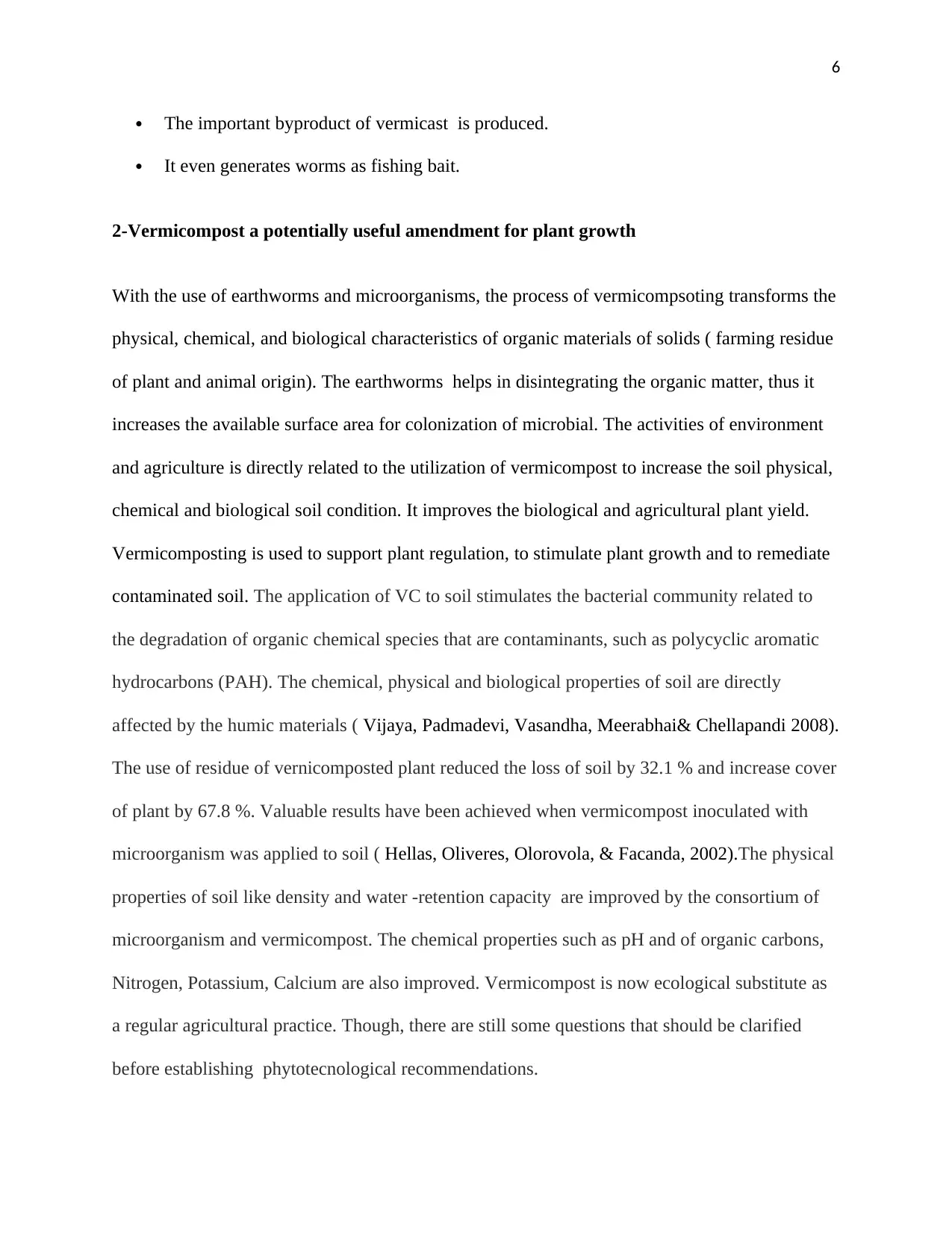
6
The important byproduct of vermicast is produced.
It even generates worms as fishing bait.
2-Vermicompost a potentially useful amendment for plant growth
With the use of earthworms and microorganisms, the process of vermicompsoting transforms the
physical, chemical, and biological characteristics of organic materials of solids ( farming residue
of plant and animal origin). The earthworms helps in disintegrating the organic matter, thus it
increases the available surface area for colonization of microbial. The activities of environment
and agriculture is directly related to the utilization of vermicompost to increase the soil physical,
chemical and biological soil condition. It improves the biological and agricultural plant yield.
Vermicomposting is used to support plant regulation, to stimulate plant growth and to remediate
contaminated soil. The application of VC to soil stimulates the bacterial community related to
the degradation of organic chemical species that are contaminants, such as polycyclic aromatic
hydrocarbons (PAH). The chemical, physical and biological properties of soil are directly
affected by the humic materials ( Vijaya, Padmadevi, Vasandha, Meerabhai& Chellapandi 2008).
The use of residue of vernicomposted plant reduced the loss of soil by 32.1 % and increase cover
of plant by 67.8 %. Valuable results have been achieved when vermicompost inoculated with
microorganism was applied to soil ( Hellas, Oliveres, Olorovola, & Facanda, 2002).The physical
properties of soil like density and water -retention capacity are improved by the consortium of
microorganism and vermicompost. The chemical properties such as pH and of organic carbons,
Nitrogen, Potassium, Calcium are also improved. Vermicompost is now ecological substitute as
a regular agricultural practice. Though, there are still some questions that should be clarified
before establishing phytotecnological recommendations.
The important byproduct of vermicast is produced.
It even generates worms as fishing bait.
2-Vermicompost a potentially useful amendment for plant growth
With the use of earthworms and microorganisms, the process of vermicompsoting transforms the
physical, chemical, and biological characteristics of organic materials of solids ( farming residue
of plant and animal origin). The earthworms helps in disintegrating the organic matter, thus it
increases the available surface area for colonization of microbial. The activities of environment
and agriculture is directly related to the utilization of vermicompost to increase the soil physical,
chemical and biological soil condition. It improves the biological and agricultural plant yield.
Vermicomposting is used to support plant regulation, to stimulate plant growth and to remediate
contaminated soil. The application of VC to soil stimulates the bacterial community related to
the degradation of organic chemical species that are contaminants, such as polycyclic aromatic
hydrocarbons (PAH). The chemical, physical and biological properties of soil are directly
affected by the humic materials ( Vijaya, Padmadevi, Vasandha, Meerabhai& Chellapandi 2008).
The use of residue of vernicomposted plant reduced the loss of soil by 32.1 % and increase cover
of plant by 67.8 %. Valuable results have been achieved when vermicompost inoculated with
microorganism was applied to soil ( Hellas, Oliveres, Olorovola, & Facanda, 2002).The physical
properties of soil like density and water -retention capacity are improved by the consortium of
microorganism and vermicompost. The chemical properties such as pH and of organic carbons,
Nitrogen, Potassium, Calcium are also improved. Vermicompost is now ecological substitute as
a regular agricultural practice. Though, there are still some questions that should be clarified
before establishing phytotecnological recommendations.
⊘ This is a preview!⊘
Do you want full access?
Subscribe today to unlock all pages.

Trusted by 1+ million students worldwide
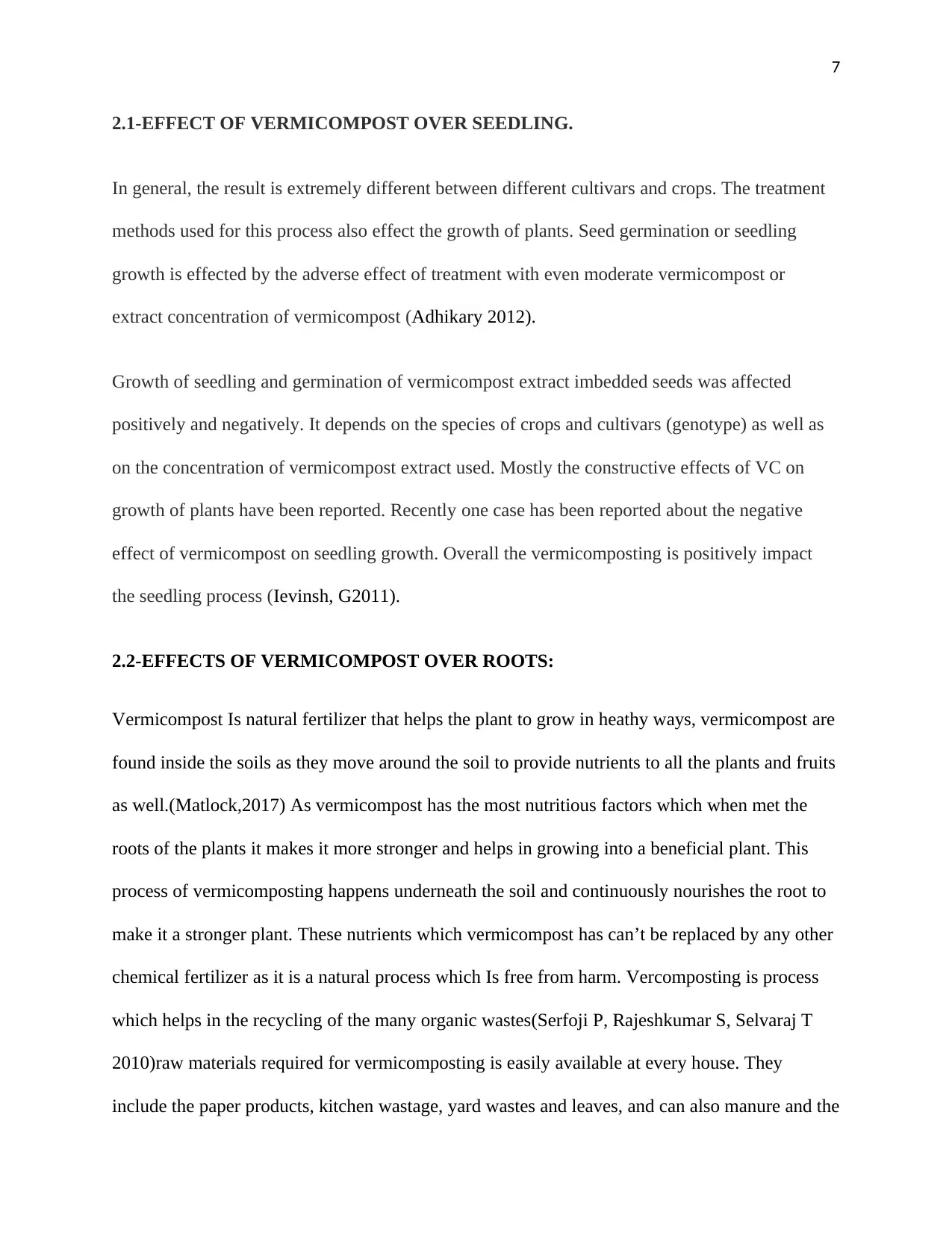
7
2.1-EFFECT OF VERMICOMPOST OVER SEEDLING.
In general, the result is extremely different between different cultivars and crops. The treatment
methods used for this process also effect the growth of plants. Seed germination or seedling
growth is effected by the adverse effect of treatment with even moderate vermicompost or
extract concentration of vermicompost (Adhikary 2012).
Growth of seedling and germination of vermicompost extract imbedded seeds was affected
positively and negatively. It depends on the species of crops and cultivars (genotype) as well as
on the concentration of vermicompost extract used. Mostly the constructive effects of VC on
growth of plants have been reported. Recently one case has been reported about the negative
effect of vermicompost on seedling growth. Overall the vermicomposting is positively impact
the seedling process (Ievinsh, G2011).
2.2-EFFECTS OF VERMICOMPOST OVER ROOTS:
Vermicompost Is natural fertilizer that helps the plant to grow in heathy ways, vermicompost are
found inside the soils as they move around the soil to provide nutrients to all the plants and fruits
as well.(Matlock,2017) As vermicompost has the most nutritious factors which when met the
roots of the plants it makes it more stronger and helps in growing into a beneficial plant. This
process of vermicomposting happens underneath the soil and continuously nourishes the root to
make it a stronger plant. These nutrients which vermicompost has can’t be replaced by any other
chemical fertilizer as it is a natural process which Is free from harm. Vercomposting is process
which helps in the recycling of the many organic wastes(Serfoji P, Rajeshkumar S, Selvaraj T
2010)raw materials required for vermicomposting is easily available at every house. They
include the paper products, kitchen wastage, yard wastes and leaves, and can also manure and the
2.1-EFFECT OF VERMICOMPOST OVER SEEDLING.
In general, the result is extremely different between different cultivars and crops. The treatment
methods used for this process also effect the growth of plants. Seed germination or seedling
growth is effected by the adverse effect of treatment with even moderate vermicompost or
extract concentration of vermicompost (Adhikary 2012).
Growth of seedling and germination of vermicompost extract imbedded seeds was affected
positively and negatively. It depends on the species of crops and cultivars (genotype) as well as
on the concentration of vermicompost extract used. Mostly the constructive effects of VC on
growth of plants have been reported. Recently one case has been reported about the negative
effect of vermicompost on seedling growth. Overall the vermicomposting is positively impact
the seedling process (Ievinsh, G2011).
2.2-EFFECTS OF VERMICOMPOST OVER ROOTS:
Vermicompost Is natural fertilizer that helps the plant to grow in heathy ways, vermicompost are
found inside the soils as they move around the soil to provide nutrients to all the plants and fruits
as well.(Matlock,2017) As vermicompost has the most nutritious factors which when met the
roots of the plants it makes it more stronger and helps in growing into a beneficial plant. This
process of vermicomposting happens underneath the soil and continuously nourishes the root to
make it a stronger plant. These nutrients which vermicompost has can’t be replaced by any other
chemical fertilizer as it is a natural process which Is free from harm. Vercomposting is process
which helps in the recycling of the many organic wastes(Serfoji P, Rajeshkumar S, Selvaraj T
2010)raw materials required for vermicomposting is easily available at every house. They
include the paper products, kitchen wastage, yard wastes and leaves, and can also manure and the
Paraphrase This Document
Need a fresh take? Get an instant paraphrase of this document with our AI Paraphraser
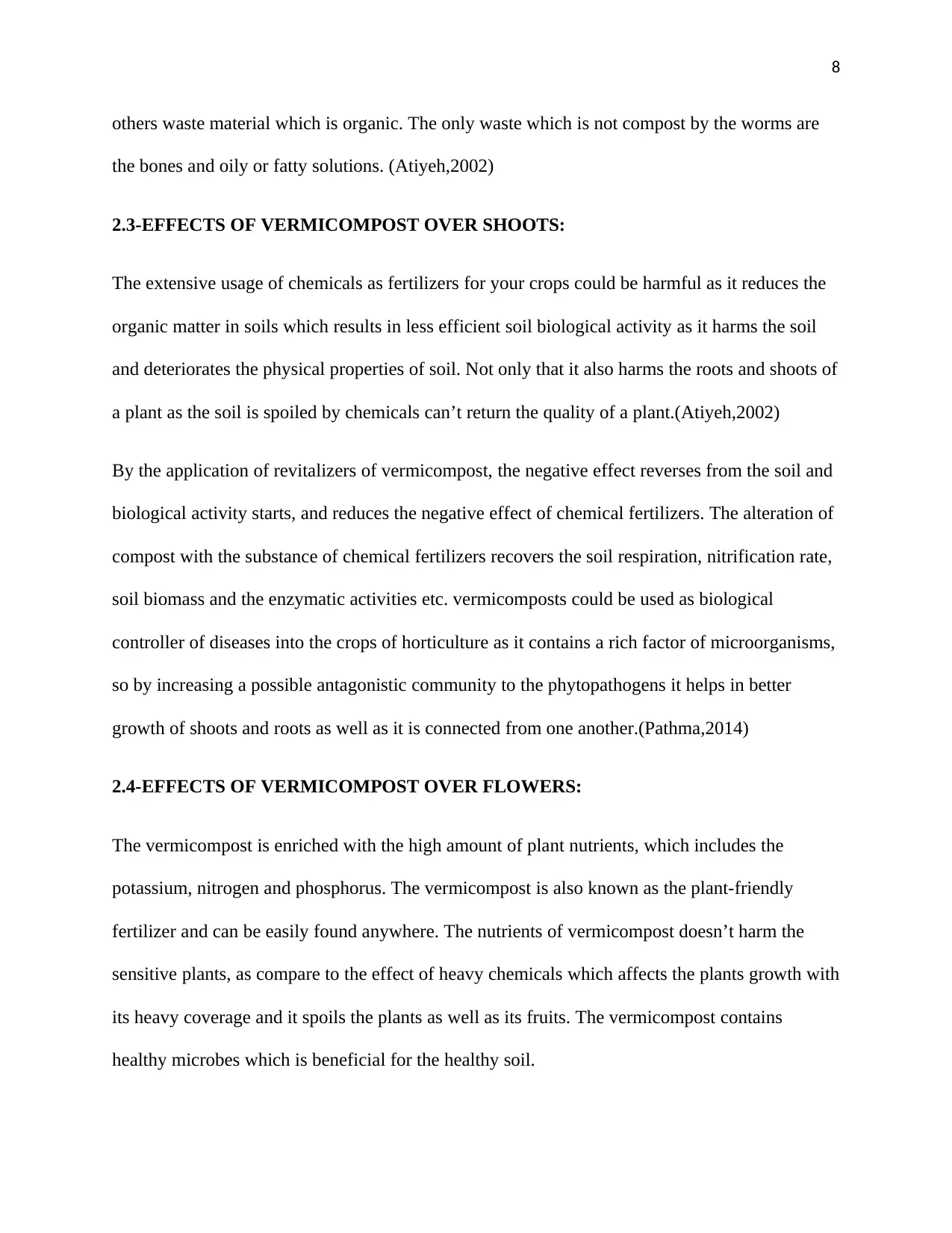
8
others waste material which is organic. The only waste which is not compost by the worms are
the bones and oily or fatty solutions. (Atiyeh,2002)
2.3-EFFECTS OF VERMICOMPOST OVER SHOOTS:
The extensive usage of chemicals as fertilizers for your crops could be harmful as it reduces the
organic matter in soils which results in less efficient soil biological activity as it harms the soil
and deteriorates the physical properties of soil. Not only that it also harms the roots and shoots of
a plant as the soil is spoiled by chemicals can’t return the quality of a plant.(Atiyeh,2002)
By the application of revitalizers of vermicompost, the negative effect reverses from the soil and
biological activity starts, and reduces the negative effect of chemical fertilizers. The alteration of
compost with the substance of chemical fertilizers recovers the soil respiration, nitrification rate,
soil biomass and the enzymatic activities etc. vermicomposts could be used as biological
controller of diseases into the crops of horticulture as it contains a rich factor of microorganisms,
so by increasing a possible antagonistic community to the phytopathogens it helps in better
growth of shoots and roots as well as it is connected from one another.(Pathma,2014)
2.4-EFFECTS OF VERMICOMPOST OVER FLOWERS:
The vermicompost is enriched with the high amount of plant nutrients, which includes the
potassium, nitrogen and phosphorus. The vermicompost is also known as the plant-friendly
fertilizer and can be easily found anywhere. The nutrients of vermicompost doesn’t harm the
sensitive plants, as compare to the effect of heavy chemicals which affects the plants growth with
its heavy coverage and it spoils the plants as well as its fruits. The vermicompost contains
healthy microbes which is beneficial for the healthy soil.
others waste material which is organic. The only waste which is not compost by the worms are
the bones and oily or fatty solutions. (Atiyeh,2002)
2.3-EFFECTS OF VERMICOMPOST OVER SHOOTS:
The extensive usage of chemicals as fertilizers for your crops could be harmful as it reduces the
organic matter in soils which results in less efficient soil biological activity as it harms the soil
and deteriorates the physical properties of soil. Not only that it also harms the roots and shoots of
a plant as the soil is spoiled by chemicals can’t return the quality of a plant.(Atiyeh,2002)
By the application of revitalizers of vermicompost, the negative effect reverses from the soil and
biological activity starts, and reduces the negative effect of chemical fertilizers. The alteration of
compost with the substance of chemical fertilizers recovers the soil respiration, nitrification rate,
soil biomass and the enzymatic activities etc. vermicomposts could be used as biological
controller of diseases into the crops of horticulture as it contains a rich factor of microorganisms,
so by increasing a possible antagonistic community to the phytopathogens it helps in better
growth of shoots and roots as well as it is connected from one another.(Pathma,2014)
2.4-EFFECTS OF VERMICOMPOST OVER FLOWERS:
The vermicompost is enriched with the high amount of plant nutrients, which includes the
potassium, nitrogen and phosphorus. The vermicompost is also known as the plant-friendly
fertilizer and can be easily found anywhere. The nutrients of vermicompost doesn’t harm the
sensitive plants, as compare to the effect of heavy chemicals which affects the plants growth with
its heavy coverage and it spoils the plants as well as its fruits. The vermicompost contains
healthy microbes which is beneficial for the healthy soil.
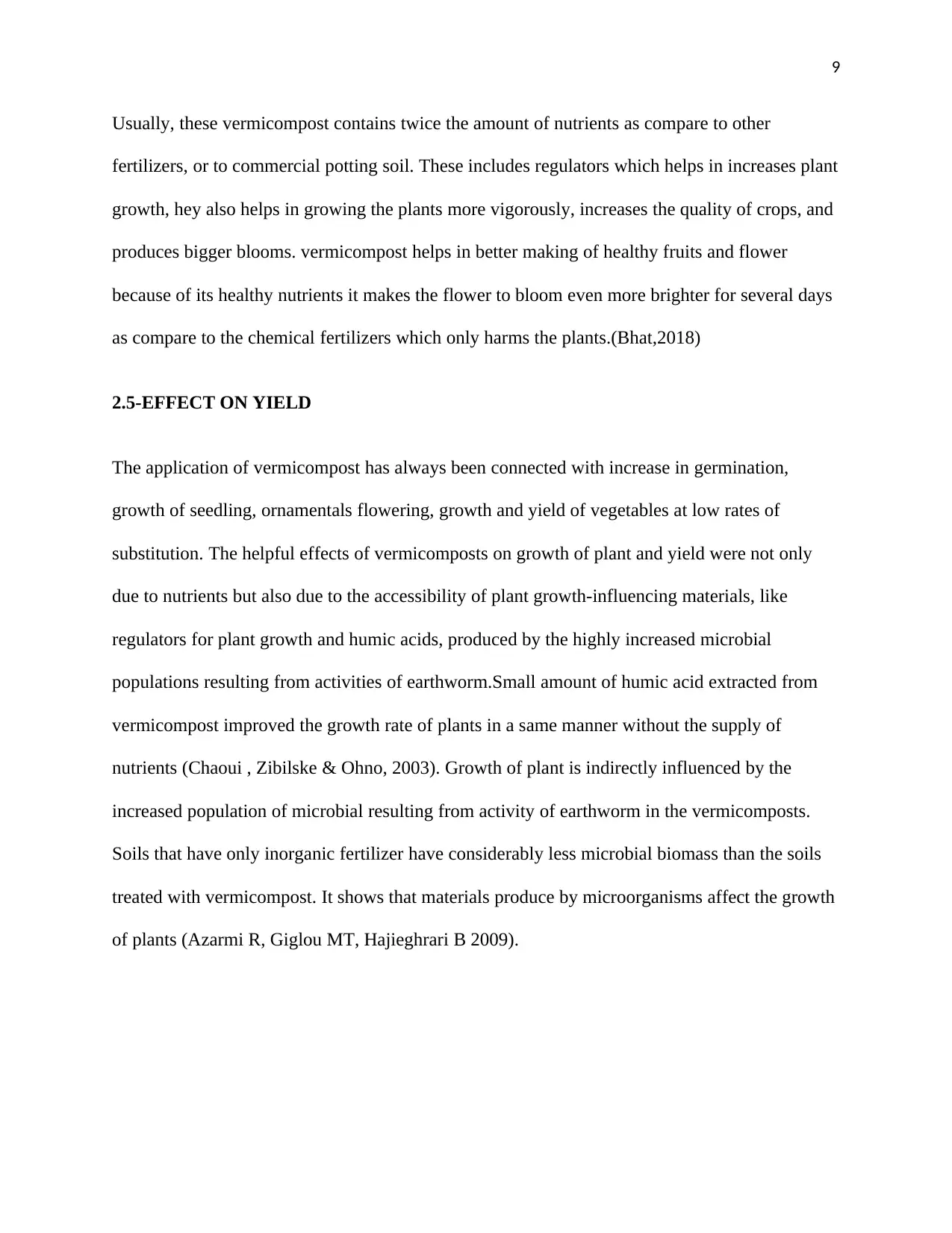
9
Usually, these vermicompost contains twice the amount of nutrients as compare to other
fertilizers, or to commercial potting soil. These includes regulators which helps in increases plant
growth, hey also helps in growing the plants more vigorously, increases the quality of crops, and
produces bigger blooms. vermicompost helps in better making of healthy fruits and flower
because of its healthy nutrients it makes the flower to bloom even more brighter for several days
as compare to the chemical fertilizers which only harms the plants.(Bhat,2018)
2.5-EFFECT ON YIELD
The application of vermicompost has always been connected with increase in germination,
growth of seedling, ornamentals flowering, growth and yield of vegetables at low rates of
substitution. The helpful effects of vermicomposts on growth of plant and yield were not only
due to nutrients but also due to the accessibility of plant growth-influencing materials, like
regulators for plant growth and humic acids, produced by the highly increased microbial
populations resulting from activities of earthworm.Small amount of humic acid extracted from
vermicompost improved the growth rate of plants in a same manner without the supply of
nutrients (Chaoui , Zibilske & Ohno, 2003). Growth of plant is indirectly influenced by the
increased population of microbial resulting from activity of earthworm in the vermicomposts.
Soils that have only inorganic fertilizer have considerably less microbial biomass than the soils
treated with vermicompost. It shows that materials produce by microorganisms affect the growth
of plants (Azarmi R, Giglou MT, Hajieghrari B 2009).
Usually, these vermicompost contains twice the amount of nutrients as compare to other
fertilizers, or to commercial potting soil. These includes regulators which helps in increases plant
growth, hey also helps in growing the plants more vigorously, increases the quality of crops, and
produces bigger blooms. vermicompost helps in better making of healthy fruits and flower
because of its healthy nutrients it makes the flower to bloom even more brighter for several days
as compare to the chemical fertilizers which only harms the plants.(Bhat,2018)
2.5-EFFECT ON YIELD
The application of vermicompost has always been connected with increase in germination,
growth of seedling, ornamentals flowering, growth and yield of vegetables at low rates of
substitution. The helpful effects of vermicomposts on growth of plant and yield were not only
due to nutrients but also due to the accessibility of plant growth-influencing materials, like
regulators for plant growth and humic acids, produced by the highly increased microbial
populations resulting from activities of earthworm.Small amount of humic acid extracted from
vermicompost improved the growth rate of plants in a same manner without the supply of
nutrients (Chaoui , Zibilske & Ohno, 2003). Growth of plant is indirectly influenced by the
increased population of microbial resulting from activity of earthworm in the vermicomposts.
Soils that have only inorganic fertilizer have considerably less microbial biomass than the soils
treated with vermicompost. It shows that materials produce by microorganisms affect the growth
of plants (Azarmi R, Giglou MT, Hajieghrari B 2009).
⊘ This is a preview!⊘
Do you want full access?
Subscribe today to unlock all pages.

Trusted by 1+ million students worldwide
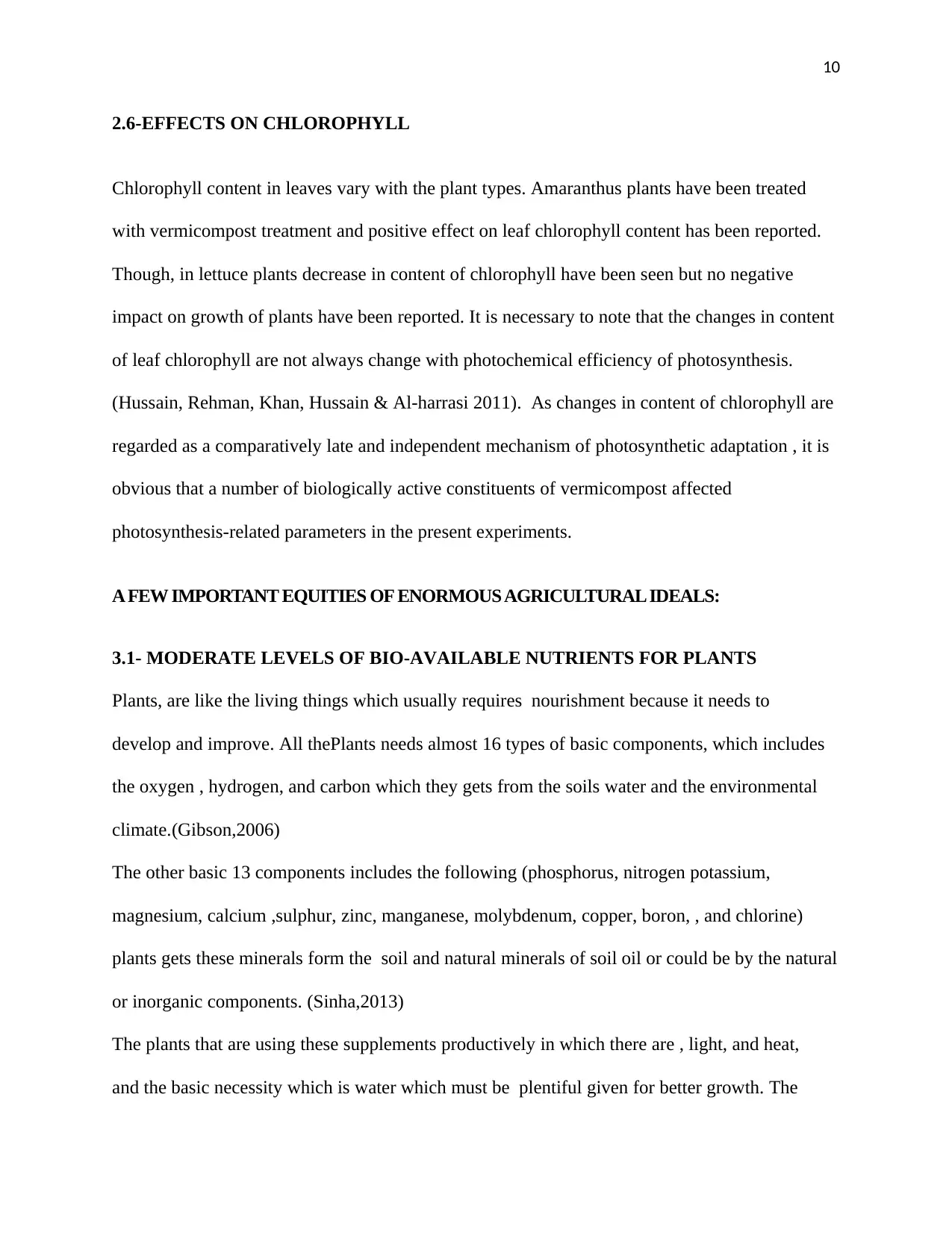
10
2.6-EFFECTS ON CHLOROPHYLL
Chlorophyll content in leaves vary with the plant types. Amaranthus plants have been treated
with vermicompost treatment and positive effect on leaf chlorophyll content has been reported.
Though, in lettuce plants decrease in content of chlorophyll have been seen but no negative
impact on growth of plants have been reported. It is necessary to note that the changes in content
of leaf chlorophyll are not always change with photochemical efficiency of photosynthesis.
(Hussain, Rehman, Khan, Hussain & Al-harrasi 2011). As changes in content of chlorophyll are
regarded as a comparatively late and independent mechanism of photosynthetic adaptation , it is
obvious that a number of biologically active constituents of vermicompost affected
photosynthesis-related parameters in the present experiments.
A FEW IMPORTANT EQUITIES OF ENORMOUS AGRICULTURAL IDEALS:
3.1- MODERATE LEVELS OF BIO-AVAILABLE NUTRIENTS FOR PLANTS
Plants, are like the living things which usually requires nourishment because it needs to
develop and improve. All thePlants needs almost 16 types of basic components, which includes
the oxygen , hydrogen, and carbon which they gets from the soils water and the environmental
climate.(Gibson,2006)
The other basic 13 components includes the following (phosphorus, nitrogen potassium,
magnesium, calcium ,sulphur, zinc, manganese, molybdenum, copper, boron, , and chlorine)
plants gets these minerals form the soil and natural minerals of soil oil or could be by the natural
or inorganic components. (Sinha,2013)
The plants that are using these supplements productively in which there are , light, and heat,
and the basic necessity which is water which must be plentiful given for better growth. The
2.6-EFFECTS ON CHLOROPHYLL
Chlorophyll content in leaves vary with the plant types. Amaranthus plants have been treated
with vermicompost treatment and positive effect on leaf chlorophyll content has been reported.
Though, in lettuce plants decrease in content of chlorophyll have been seen but no negative
impact on growth of plants have been reported. It is necessary to note that the changes in content
of leaf chlorophyll are not always change with photochemical efficiency of photosynthesis.
(Hussain, Rehman, Khan, Hussain & Al-harrasi 2011). As changes in content of chlorophyll are
regarded as a comparatively late and independent mechanism of photosynthetic adaptation , it is
obvious that a number of biologically active constituents of vermicompost affected
photosynthesis-related parameters in the present experiments.
A FEW IMPORTANT EQUITIES OF ENORMOUS AGRICULTURAL IDEALS:
3.1- MODERATE LEVELS OF BIO-AVAILABLE NUTRIENTS FOR PLANTS
Plants, are like the living things which usually requires nourishment because it needs to
develop and improve. All thePlants needs almost 16 types of basic components, which includes
the oxygen , hydrogen, and carbon which they gets from the soils water and the environmental
climate.(Gibson,2006)
The other basic 13 components includes the following (phosphorus, nitrogen potassium,
magnesium, calcium ,sulphur, zinc, manganese, molybdenum, copper, boron, , and chlorine)
plants gets these minerals form the soil and natural minerals of soil oil or could be by the natural
or inorganic components. (Sinha,2013)
The plants that are using these supplements productively in which there are , light, and heat,
and the basic necessity which is water which must be plentiful given for better growth. The
Paraphrase This Document
Need a fresh take? Get an instant paraphrase of this document with our AI Paraphraser
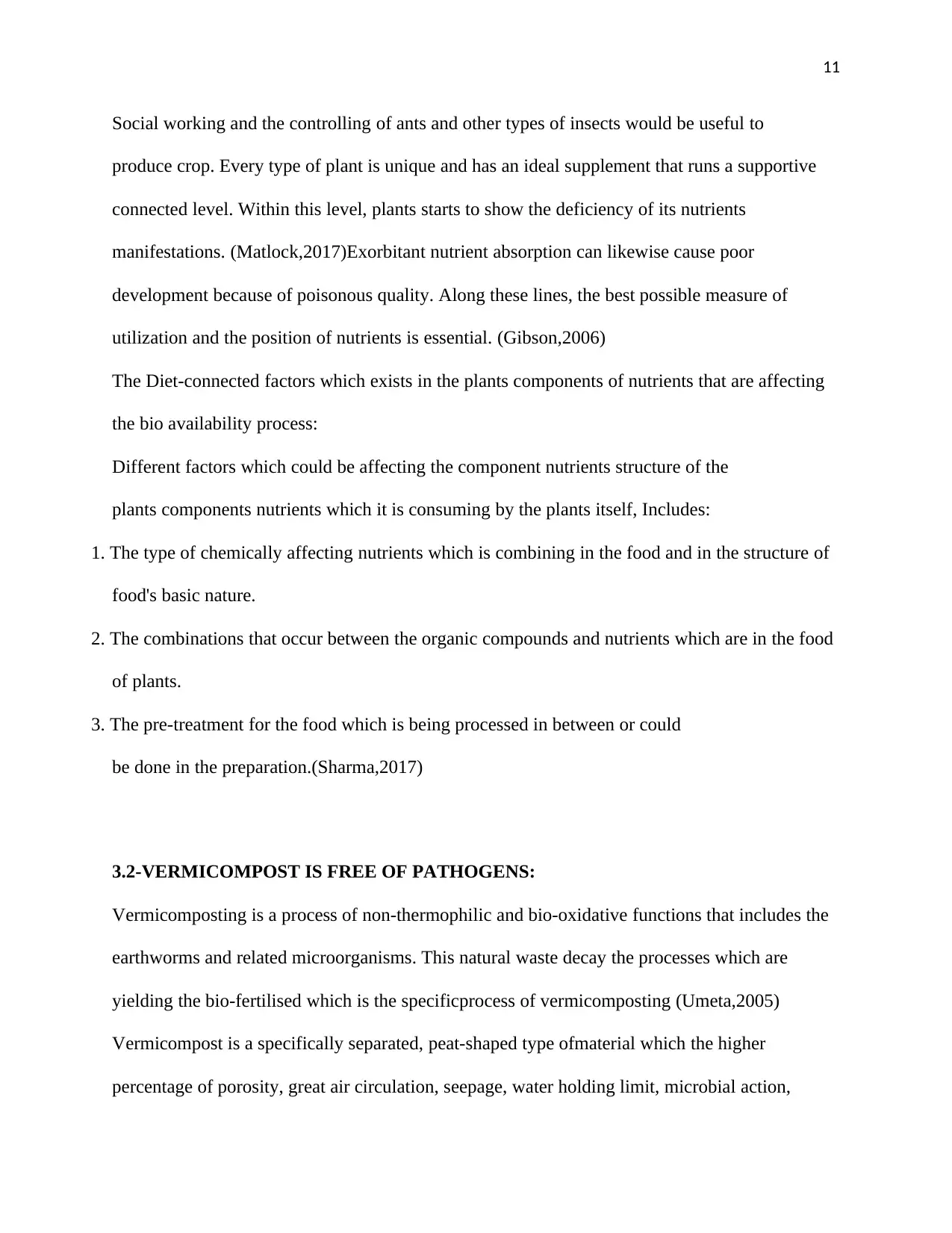
11
Social working and the controlling of ants and other types of insects would be useful to
produce crop. Every type of plant is unique and has an ideal supplement that runs a supportive
connected level. Within this level, plants starts to show the deficiency of its nutrients
manifestations. (Matlock,2017)Exorbitant nutrient absorption can likewise cause poor
development because of poisonous quality. Along these lines, the best possible measure of
utilization and the position of nutrients is essential. (Gibson,2006)
The Diet-connected factors which exists in the plants components of nutrients that are affecting
the bio availability process:
Different factors which could be affecting the component nutrients structure of the
plants components nutrients which it is consuming by the plants itself, Includes:
1. The type of chemically affecting nutrients which is combining in the food and in the structure of
food's basic nature.
2. The combinations that occur between the organic compounds and nutrients which are in the food
of plants.
3. The pre-treatment for the food which is being processed in between or could
be done in the preparation.(Sharma,2017)
3.2-VERMICOMPOST IS FREE OF PATHOGENS:
Vermicomposting is a process of non-thermophilic and bio-oxidative functions that includes the
earthworms and related microorganisms. This natural waste decay the processes which are
yielding the bio-fertilised which is the specificprocess of vermicomposting (Umeta,2005)
Vermicompost is a specifically separated, peat-shaped type ofmaterial which the higher
percentage of porosity, great air circulation, seepage, water holding limit, microbial action,
Social working and the controlling of ants and other types of insects would be useful to
produce crop. Every type of plant is unique and has an ideal supplement that runs a supportive
connected level. Within this level, plants starts to show the deficiency of its nutrients
manifestations. (Matlock,2017)Exorbitant nutrient absorption can likewise cause poor
development because of poisonous quality. Along these lines, the best possible measure of
utilization and the position of nutrients is essential. (Gibson,2006)
The Diet-connected factors which exists in the plants components of nutrients that are affecting
the bio availability process:
Different factors which could be affecting the component nutrients structure of the
plants components nutrients which it is consuming by the plants itself, Includes:
1. The type of chemically affecting nutrients which is combining in the food and in the structure of
food's basic nature.
2. The combinations that occur between the organic compounds and nutrients which are in the food
of plants.
3. The pre-treatment for the food which is being processed in between or could
be done in the preparation.(Sharma,2017)
3.2-VERMICOMPOST IS FREE OF PATHOGENS:
Vermicomposting is a process of non-thermophilic and bio-oxidative functions that includes the
earthworms and related microorganisms. This natural waste decay the processes which are
yielding the bio-fertilised which is the specificprocess of vermicomposting (Umeta,2005)
Vermicompost is a specifically separated, peat-shaped type ofmaterial which the higher
percentage of porosity, great air circulation, seepage, water holding limit, microbial action,
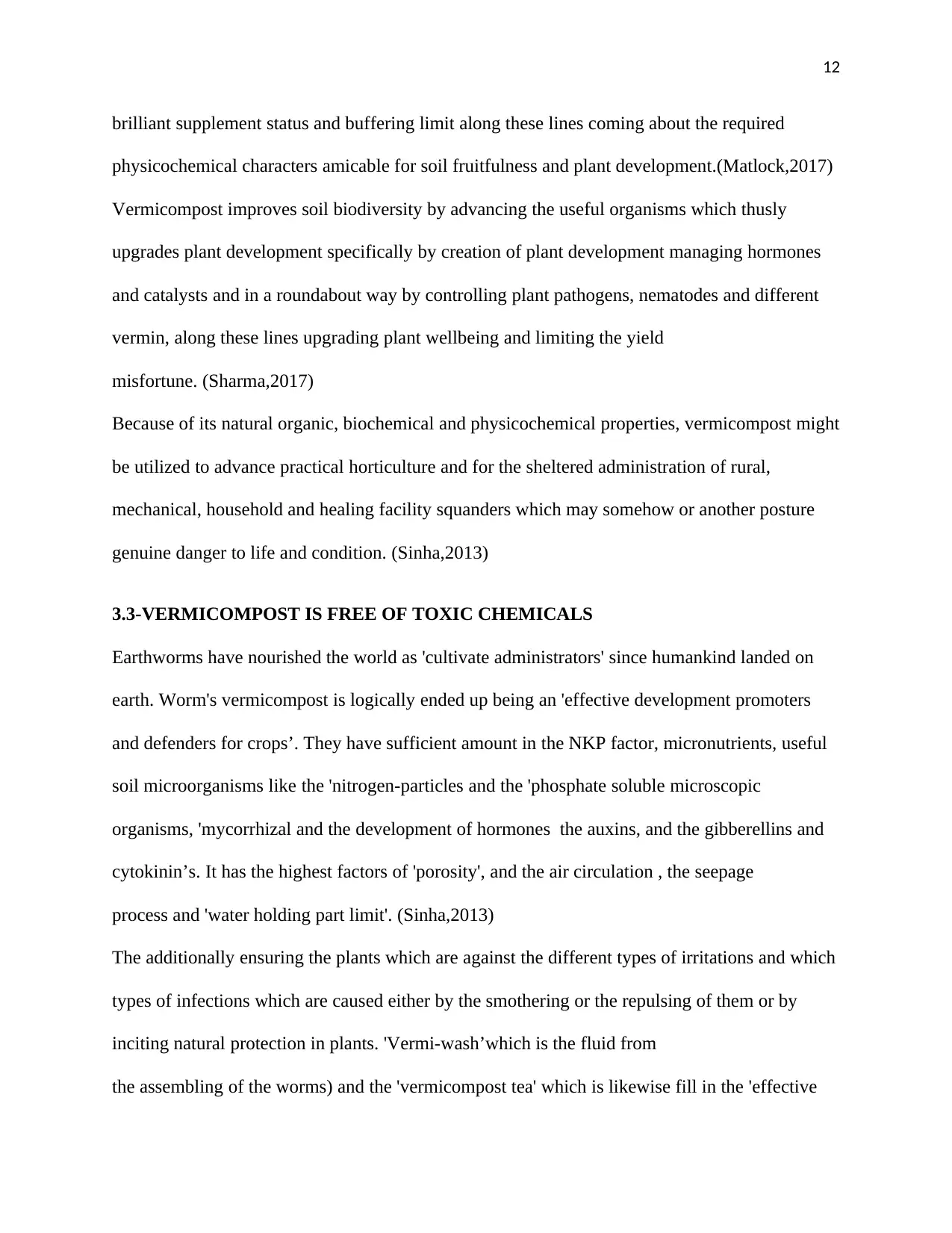
12
brilliant supplement status and buffering limit along these lines coming about the required
physicochemical characters amicable for soil fruitfulness and plant development.(Matlock,2017)
Vermicompost improves soil biodiversity by advancing the useful organisms which thusly
upgrades plant development specifically by creation of plant development managing hormones
and catalysts and in a roundabout way by controlling plant pathogens, nematodes and different
vermin, along these lines upgrading plant wellbeing and limiting the yield
misfortune. (Sharma,2017)
Because of its natural organic, biochemical and physicochemical properties, vermicompost might
be utilized to advance practical horticulture and for the sheltered administration of rural,
mechanical, household and healing facility squanders which may somehow or another posture
genuine danger to life and condition. (Sinha,2013)
3.3-VERMICOMPOST IS FREE OF TOXIC CHEMICALS
Earthworms have nourished the world as 'cultivate administrators' since humankind landed on
earth. Worm's vermicompost is logically ended up being an 'effective development promoters
and defenders for crops’. They have sufficient amount in the NKP factor, micronutrients, useful
soil microorganisms like the 'nitrogen-particles and the 'phosphate soluble microscopic
organisms, 'mycorrhizal and the development of hormones the auxins, and the gibberellins and
cytokinin’s. It has the highest factors of 'porosity', and the air circulation , the seepage
process and 'water holding part limit'. (Sinha,2013)
The additionally ensuring the plants which are against the different types of irritations and which
types of infections which are caused either by the smothering or the repulsing of them or by
inciting natural protection in plants. 'Vermi-wash’which is the fluid from
the assembling of the worms) and the 'vermicompost tea' which is likewise fill in the 'effective
brilliant supplement status and buffering limit along these lines coming about the required
physicochemical characters amicable for soil fruitfulness and plant development.(Matlock,2017)
Vermicompost improves soil biodiversity by advancing the useful organisms which thusly
upgrades plant development specifically by creation of plant development managing hormones
and catalysts and in a roundabout way by controlling plant pathogens, nematodes and different
vermin, along these lines upgrading plant wellbeing and limiting the yield
misfortune. (Sharma,2017)
Because of its natural organic, biochemical and physicochemical properties, vermicompost might
be utilized to advance practical horticulture and for the sheltered administration of rural,
mechanical, household and healing facility squanders which may somehow or another posture
genuine danger to life and condition. (Sinha,2013)
3.3-VERMICOMPOST IS FREE OF TOXIC CHEMICALS
Earthworms have nourished the world as 'cultivate administrators' since humankind landed on
earth. Worm's vermicompost is logically ended up being an 'effective development promoters
and defenders for crops’. They have sufficient amount in the NKP factor, micronutrients, useful
soil microorganisms like the 'nitrogen-particles and the 'phosphate soluble microscopic
organisms, 'mycorrhizal and the development of hormones the auxins, and the gibberellins and
cytokinin’s. It has the highest factors of 'porosity', and the air circulation , the seepage
process and 'water holding part limit'. (Sinha,2013)
The additionally ensuring the plants which are against the different types of irritations and which
types of infections which are caused either by the smothering or the repulsing of them or by
inciting natural protection in plants. 'Vermi-wash’which is the fluid from
the assembling of the worms) and the 'vermicompost tea' which is likewise fill in the 'effective
⊘ This is a preview!⊘
Do you want full access?
Subscribe today to unlock all pages.

Trusted by 1+ million students worldwide
1 out of 20
Related Documents
Your All-in-One AI-Powered Toolkit for Academic Success.
+13062052269
info@desklib.com
Available 24*7 on WhatsApp / Email
![[object Object]](/_next/static/media/star-bottom.7253800d.svg)
Unlock your academic potential
Copyright © 2020–2025 A2Z Services. All Rights Reserved. Developed and managed by ZUCOL.



